Space Tourism and the World of Robert Bigelow
Robert Bigelow
Robert Bigelow, a 1967 graduate of the University of Arizona with a Bachelor of Science Degree in Business Administration, is a member of the University of Nevada at Las Vegas (UNLV) Foundation and an associate member of the Society for Scientific Exploration. In 1999 he founded Bigelow Aerospace (BA), a company responsible for the research, development and economic breakthroughs of habitable space stations, private enterprise space launch facilities, and space transportation in the developing areas of space tourism and the future of space travel. A powerful strong-minded individual who is not only developing the first in a long line of Bigelow Sundancer space hotels, he was also the original founder of the Budget Suites of America hotel chain with over 30 years experience. For those who would enjoy listening to his August 24, 2006 speech with Dr. Livingston on The Space Show, listen to this stream.
The prominent name of the Nevada millionaire Robert Bigelow hit the space news with a big impact in 2004, when it was announced that Bigelow Aerospace of North Las Vegas, Nevada, had developed the "America's Space Prize" to promote space travel into low Earth orbit with a $50 million dollar purse--five times the amount of the previously won $10 million Ansari X Prize. Bigelow developed his contest to further develop space tourism while utilizing everyone's key ambition of a "cold hard cash prize". His thoughts were to more or less break Russia's hold in space that was held by their Soyuz spacecraft, while ultimately pushing private-funded space travel for space tourism into low orbit.
Space Tourism and Space Travel is Big Name Business
Today, there are many big names in the advancing space tourism field, such as tSpace, Rocketplane Kistler, and SpaceX. Robert Bigelow and Bigelow Aerospace are presently working with the new company, SpaceX, to place Bigelow's 19,000-pound Sundancer hotel into low orbit around 2009 or 2010 with their Falcon 9 rocket launch—even though SpaceX's timetable for a long time was calling for an earlier launching in late 2008.
Two of the many large giants in the space industry, Bigelow Aerospace and Lockheed Martin, have entered into a joint deal to move towards using Atlas V for private manned space flight--which would include space tourists and other paying passengers. The highly-established non-private firm Lockheed Martin is considered typically a big developer of NASA space technology, with this move by Lockheed seen that they may be moving where the money is—the space tourism market. An open area, the only big player until now has been Russia's Soyuz, with Bigelow feeling after more than a decade since the Apollo 11 Moon landing made space travel history, it was time to advance forth into space with something besides memories. Presently there is a huge potential in orbital tourism marketing for big money to enter, as it has pretty much been the domain of small "New Space" business companies.
Considered a beginning phase of technical and business model studies, a future study was developed to look at Atlas V's ability to be used in space tourism, which would include deciding whether or not 16 annual launchings was even possible. This move was seen as a major step to transform the traditional launching marketplace and the idea of what "New Space" was all about. By the end of January of the following year, the United Launch Alliance (ULA) was studying and promoting the use of Atlas V for the transportation of commercial passengers. This study includes transportation and space tourism to the site of Robert Bigelow's Aerospace orbital station and transportation-part of the original deal with Lockheed Martin.
The Success of the Genesis Prototype Hotel
Robert Bigelow has been a big name in the world for awhile, but he has recently attracted even more attention through the eyes of the entire world with his successful launching of the two Genesis modules. Using them as test modules for his Sundancer space hotel, the successful launching of Genesis I, their first prototype, have put plans into high gear for future modules from not only his company but sister companies embarking on similar missions.
Genesis I
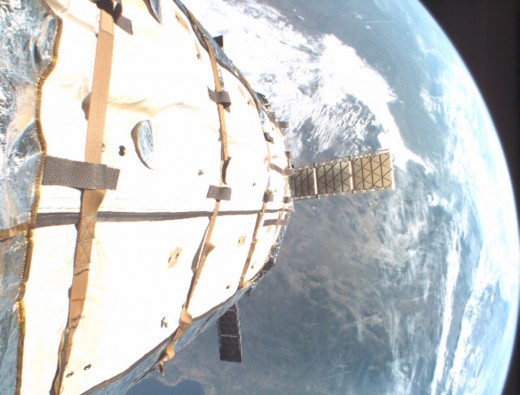
Genesis I
Genesis I was launched in July 12, 2006, a small prototype in a length of 15 feet with the module filling out to eight feet in diameter once in space, yielding about 11.5 cubic meters of an area that is considered usable. Launched aboard a Russian Dnepr rocket (a ICBM that was converted for Bigelow's commercial usage), it was able to reach its 340-mile orbit very soon—leaving the Siberian Dombarovsky missile base successfully to head toward its destination. Once in space, it was able to activate its computer controller air pressure tanks, allowing it to expand its pre-folded structure into a watermelon-shaped miniature version of a space hotel. This was considered a major step toward revolutionizing space commerce.
Energy is received through eight solar arrays, with four on each end of the craft. With not only a successful launch in July of 2006, it also is successfully orbiting to this day. Remaining on a successful level are its 78-degree temperature, battery power, avionics, and solar arrays while having adequate direct sunlight to allow a charge the main battery to remain in maximum capacity.
Inside Genesis II
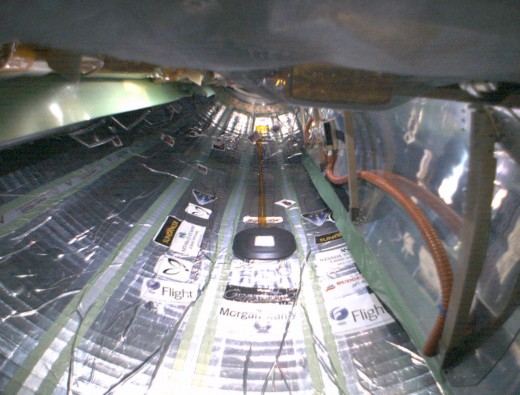
Genesis Pathfinder Modules
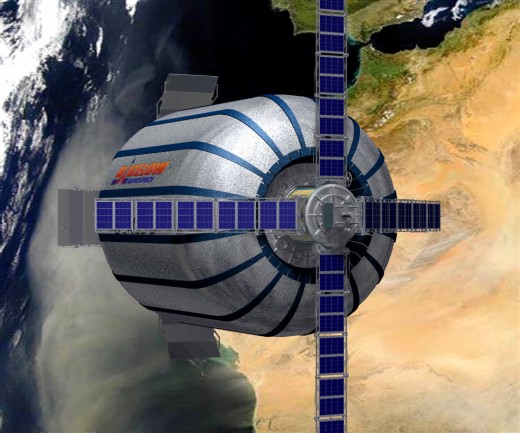
Genesis II
Bigelow's second 33% prototype, Genesis II, was sent up on June 28, 2007 onboard the Missile Complex from Kosmotras Space. It is also being used to test and validate for Bigelow Aerospace's Sundancer space hotel—an orbiting full scale commercial space complex to support a crew of three. Larger than the physical make-up of Genesis I, the second version contains more systems than its predecessor—a reaction wheel, a Biobox, additional cameras which brings it to 22, sensors, and an interactive Space Bingo game. When launching it was approximately 14-feet in length and four feet in diameter. Once in orbital space 342-miles above Earth , it inflated to about twice that size.
Robert Bigelow had promoted the public image of Genesis II through a commercial pilot program called "Fly Your Stuff" which had allowed the general public to send something of their own into space for $295.00 each or $265 each for three to five personal items. A farmable certificate was sent to each general participate who sent items up prior to its launching.
Since its original launching, data and images are being received continuously to Bigelow's Aerospace's Mission Control Center—located in North Las Vegas, Nevada. Setting the stage for Bigelow's future space orbital complexes, it has provided successful testing of the first in-orbit image projection system to the world, instead of just one mission control department.
New Scientist Video -Inflatable space stations take off
Development of the Sundancer Hotel
With Robert Bigelow's space dream since he was 15-years old coming true in the very near future, Bigelow's Sundancer hotel will be a larger version of his company's subscales Genesis I and Genesis II spacecraft that are presently in orbit. The Sundancer will have 175 cubic meters of space that is livable, fully equipped with life support systems, ability to re-boost itself, attitude control, and when it's time is up—able to conduct its own controlled de-orbit to its final resting place.
When it is first up, it will be able to hold a crew of three individuals for varying periods of time, forming the backbone of additional components to develop itself into the first commercial space station, offering a reliable environment for varying purposes. Within the next three month period, visitors from many fields will be visiting the Sundancer in Las Vegas to view its progress—users from the biotech field, medical research fields, and the pharmaceutical fields.
"We're trying to offer to folks, for multiple kinds of uses, a reliable environment that can be used for varying types of purposes. So we're kind of the wholesalers of space," Bigelow Aerospace President Robert Bigelow is quoted as saying on July 30 in an exclusive interview with Space News. "This is a little bit like 'if you build it, they will come'." As of April 1999, Bigelow has put $150 million dollars into his Bigelow Aerospace—prepared to go as high as $500 million by 2015 if needed.
Contracts in the Making for Bigelow's Sundancer Hotel
As of May 2008, Robert Bigelow and company had signed a $5 million dollar contract with Orion Propulsion Inc in Huntsville, Alabama. This company would supply the "attitude control system" for the front end of the hotel. Meanwhile in that same month, Aerojet-General Corporation of Sacramento, California, was awarded a $23 million dollar contract for the aft end of the Sundancer, supplying the propulsion system and the system to handle rendezvous and docking. And the testing for the life support gear is promising, which Bigelow thought put them on the right track.
All together, this first space complex would consist of two Sundancer-class modules, a docking nodule, a propulsion bus combination, and a single BA-330. With all of this developing in Bigelow's company sit in Las Vegas, plans are already being made to expand his test facilities and building complex with a 175,800-square foot building—to be an assembly line to make large space modules and connecting propulsion buses and docking nodes. The plans for the building are to handle two full standards per years, with one or two propulsion boxes and docking nodes a year. The plans are also to be completed by December of 2009. Meanwhile, the parking lot next to this new building is 4.9 acres.
The new building that is being built, building A3, will eventually be a template for follow-on facilities for upcoming Bigelow Aerospace's new hotels in space. Areas that are being looked at are Florida, New Mexico, Texas, or California.
Sundancer
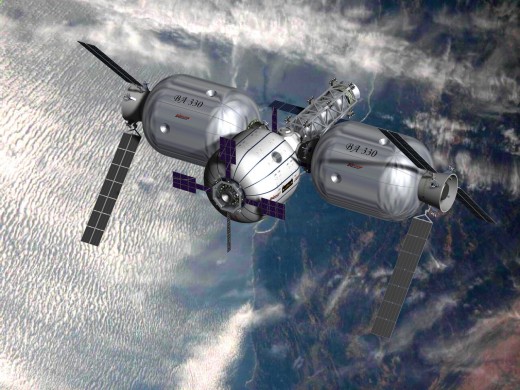
Genesis I
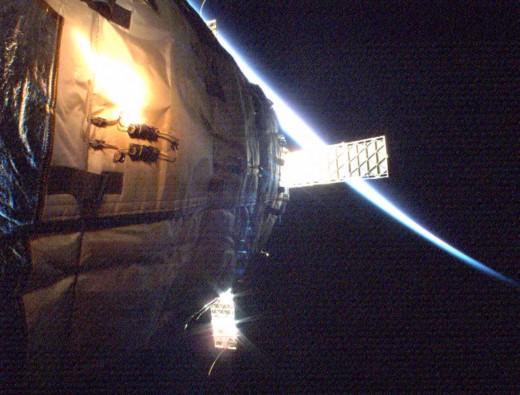
Top Activities in a Space Hotel
Most people have a desire to be on the go—and just because they are in space does not mean they do want a fun-filled day. With no television satellites to offer "Raymond" or "Cold Case", hours need to be filled in other ways.
Low-G Swimming
The number one choice of Space Monitor.com is for visitors to the space hotel go swimming in a pool with artificial gravity. The planned process is to spin the pool so the individual can float in air or go to the sides of the area. Just the thought sounds fascinating, if you know how to swim. Other ideas thrown around are space sports in gyms which also has zero-g, along with floating blobs of water.
Rooms in the Space Hotel
Similar to any hotel on Earth in many ways, the space hotel would offer one of the most fantastic view ever. The hotel would need to spin in order to maintain its artificial gravity, which would mean the view would be changing also on a continuous basis. Another "huge" advantage with the sleeping arrangements is the low-gravity effect on the body, with blood circulation held at a minimum, or falling out of bed as Velcro straps will hold a person in.
Space Sports
Playing a 3D sport is beyond the wildest imagination, with the creation of new games which require no gravity an open field. Imagine how easy it would be to play basketball now?
Trampolines
Within certain limitations, this could be a fun thing. Even on Earth the feeling of weightlessness is felt when in the air, so while lodging at one of the space hotels the effortless jumping may bring on another feeling entirely.
Weight Watching
Experiencing different feelings of weightlessness, while lifting different levels of weights, may be rather unique. Building muscle may take on another whole meaning in space.
Star Watching
Sitting outside looking at the sky won't ever feel the same after vacationing at Bigelow's Sundancer hotel. Nothing more needs to be said.
Genesis Pathfinder modules
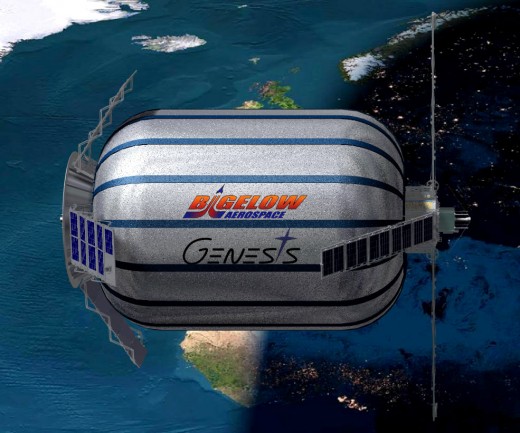
The General Public and Bigelow Aerospace
Different than most, the online website of Bigelow Aerospace provides on-the-spot information to anyone who has the desire to know more. Not a filtering endeavor, Robert Bigelow provides the latest images from his prototypes in low-orbit above Earth, the highlights of the missions, and fascinating videos. Capturing information live time, a viewer will always know where Genesis II (or the Sundancer space hotel later on) is above Earth. Remember….
"Bigelow Aerospace is dedicated to developing
next-generation crewed space complexes
to revolutionize space commerce
and open up the final frontier to all of humanity."
"At Bigelow Aerospace, we're building the future today!"
Acknowledgement
Many thanks to Bigelow Aerospace's media department for permission to use pictures approved by Robert Bigelow in this hub!
This hub brought to you...
by Julie-Ann Amos, professional writer, and owner of international writing agency www.ExquisiteWriting.com
Why not create your own HubPages? It's fun and you can make revenue from Adsense and other revenue streams on your pages. JOIN HUBPAGES NOW
This work is licenced under the Creative Commons Attribution-Non-Commercial-No Derivative Works 3.0 Unported License. To view a copy of this licence, visit http://creativecommons.org/licenses/by-nc-nd/3.0/ or send a letter to Creative Commons, 171 Second Street, Suite 300, San Francisco, California 94105, USA.








